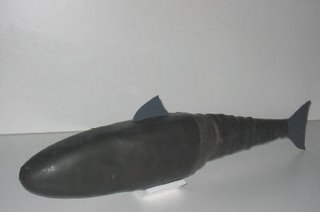Since I was just a kid, I have always been amazed how millions of small salmon smolt find their way to the ocean from the rivers in which they were hatched. They spend the majority of their young life in our marine waters then return to the river of their origin to spawn and die.
Where they travel until they reach their sexual maturity is unknown. Since the "feeder" or "winter "King Salmon" fishery has been developed in lower Cook Inlet and Kachemak Bay, they have discovered that a large percentage of these fish are visiting our waters from Canada. The migratory pattern of the Alaskan salmon remains a secret.
However, in the near future perhaps these secrets will be discovered by electronic and mechanical engineers. An underwater robot, called the "RoboSalmon" meant to spy spy on real fish is being developed at Glasow University. The RoboSalmon has a built in camera to broadcast images of real fish back to the operators. A key feature is the propulsion system. Since the robot will use its fins and tail for movement, it will be able to move through the water in a way that is more natural for aquatic creatures. 

The Alaska Department of Fish and Game has already issued an Emergency Order protecting the RoboSalmon, any RoboSalmon hooked, caught in a gill net, scoop up in a oversized landing net, or snagged must be released immediately without being removed from the water.
The U.S. Navy has also issued an Emergency Advisory, that if any RoboSalmon comes to with five nautical miles of any naval surface vessel or submarine, it will be immediately destroyed by any means necessary, including torpedoes and anti-submarine warfare missiles.
After discovering this research, I have given some very serious contemplation pertaining to the RoboSalmon and have developed my own personal opinion:
Ingenuity: I would give the engineers a high mark for the creation and development of the system.
Practicality: I would consider it a total failure and they should have spent their time and money on the development of a better iPod or faster internet modem.
I did not take these decisions lightly, however, after reviewing the picture of the RoboSalmon and with a little comparable data, the RoboSalmon silhouette and color looks very similar to that of a whale or shark. I can just picture the RoboSalmon moving into a school of salmon to view them, one sight of this monster and even though it swims like a fish, it looks like a predator. What do salmon do when a predator approaches - no RoboSalmon is going to match the speed of a salmon and all the biologists are going to see is a bunch of tails heading for deep water.
Some things are meant to be kept a secret, where our salmon travel is one of those secrets. Unlike humans, to find their way they do not need a road map, cell phone, or GPS unit. They are smarter than we are so let's leave them alone, they face enough dangers on the high seas, they do not need RoboSalmon checking up on them.
4 comments
Oh, you mean like a GPS chip that they now put in pets so they can be located, it would not work because it is to easy to think of and most likely no grant money available. Come to think of it, why don't we put chips in babies at birth - if they become lost or god forbid kidnapped, they would be easy to locate. It would work great when those babies turn into teenagers - but even a GPS chip in their cell phones would be good - they are never far away from their phones!
Don't get started on micro-chipping! Military personel have been chipped for enough years that I could have been chipped as a baby! Except, in Homer - I doubt it.
Oh, I did not know military personnel had been chipped - that accounts for the "beeping" sound that I hear on occasion.
Post a Comment
Contributors

- Stan Harrington
- Stan grew up fishing the rivers and marine waters of Cook Inlet since the 1950's. Retired from the U.S. Navy in 1983. Stan and his family owned and operated Anchor Angler Tackle Shop on Anchor River for twenty-two years. He was the host of the popular daily radio program, "Kenai Peninsula Sport Fishing Report" on radio stations KGTL, KPEN, and K-Wave for fifteen years. Stan retired from business in 2007 and continues to live in Anchor Point, Alaska.
Favorite Links
Archives
-
▼
2006
(220)
-
▼
December
(19)
- Winter Wonderland
- Just Prattling
- In Loving Memory
- Thank You
- Merry Christmas
- We Believe
- $1,000.00 Dollars
- A Very White Christmas
- Safety First
- Investment Opportunity
- Sharing the Spirit
- Christmas Past
- Salmon Secrets To Be Discovered
- Terrorism In The Sky
- December 7, 1941
- Christmas Gift Ideas
- Fall Rains
- Make the Move
- Snow Day
-
▼
December
(19)
Total Pageviews
VIisitors
Live Traffic Feed
My Blog List
-
-
Elk In The Rut13 years ago
-
-
Winter 2012 (March)13 years ago
-
-
No Need To Apologize14 years ago
-
-
-
Key, Like Kilo15 years ago
-
What Is In A Name15 years ago
-
OK HERE I AM16 years ago
-
soooo many dogs17 years ago
